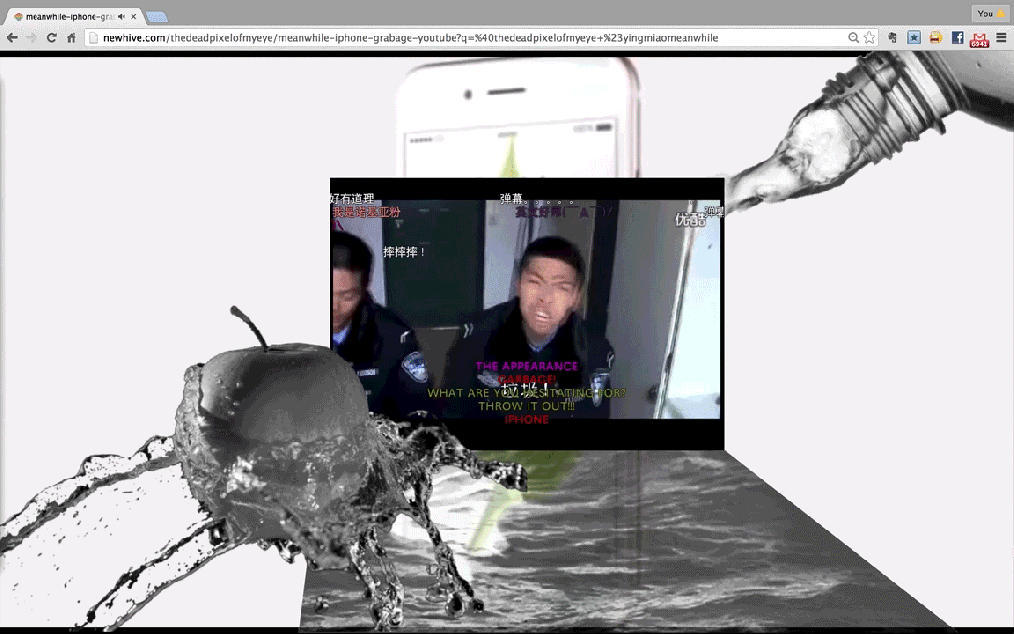top of page
DISTANCE
Benjamin tries to inform us that the traditional art has an apparitional experience, alienating viewers from the object. He writes,
"While at rest on a summers noon, to trace a range of mountain on the horizon, or a branch that throws its shadow on the observer, until the moment or the hour become part of their appearance, this is what it means to breathe the aura of those mountains, that branch."
(Selected Writings, p.518)

What is the distance? He may not give us a clear explanation. His interpretation only tries to arouse readers’ empirical memory of the particular scenario where aura can appear in our everyday experience, but does not relate this scenario to our experience of art.
Many contemporary theorists try to interpret the distance as the experience of individual contemplation.
Such as, Ferris' reinterpretation of Benjamin's aura:
Read
Robeson'
article
here!

or Robeson's writing:

Miao Ying’s Internet artworks highly question Benjamin’s argument. Each time we open her artwork through our web browser, the artwork will be generated once from the digital reproduction. However, when we see plenty of the elements in popular culture, which we are familiar with, are mixed and configured in a messy manner all over the website, we can feel the uncanny sense in which we don’t know how to interpret the meaning after the combination of diversified elements. I feel that the distance is reinstated between the viewers and the artworks in our experience of Miao Ying’s art. To understand the theme of an Internet artwork, the viewers’ individual contemplation is required.
WATCH ME

Consider her work iPhone Garbage as an example. This artwork has three components. The main component is a Bilibili video, which is a guichu remix video of the promotional commercial of Chinese smart phone brand Gionee.
(Guichu is a type of aesthetics in Chinese remix culture. It is used to refer to a type of fan-made music video, combining repeat picture (or voice) in a certain rhythm. For example, the iPhone garbage edits the commercial of Gionee smart phone to match with the rhythm of Offenbach’s Orpheus in the Underworld Overture.)
This remix video expresses strong hatred towards iPhone, with excessive amount of language violence and behavioral violence (smashing the phone). The video is superimposed with several streams of the netizens’ real-time comments, which are called danmu (the bullet subtitle) in Chinese, as well as the bilingual subtitles (English and Chinese) of the lyrics in the bottom of the video.
Another component is a TV commercial of iPhone in the background, which playbacks simultaneously with the foreground BiliBili video. It also becomes a parallel opposition to that Bilibili video, because it shows that the people use iPhone in a joyous way. The third part is a monochromatic GIF of a bottle of water pouring on an apple, which Miao Ying introduces as the metaphor of the illegally smuggled iPhone, called “Water Apple” in Chinese.
When I watch this artwork, I find that the two characters, who criticize and smash the iPhone, are two policemen. Their identity symbolizes the authority of Chinese government. With the parallel comparison between the hymnic American commercial and the satirical Chinese remix video, in my opinion, this artwork represents how the Chinese authority resists the capitalist imperialism and the economic neocolonialism from America through its symbolic destruction of an American product. Many art critics have different comments from mine. Holmes sees the iPhone Garbage as “both commentary and critique on the saturation of the Chinese market with new forms of communications technology, precipitating the insatiable desire to own the latest model of smart phone.”Valentine comments that “the iPhone Garbage represents the visual convergence of social media, Chinese manufacturing, consumerism and shanzhai culture.”The plurality of these commentary contents manifests that this Internet artwork evokes viewers’ individual contemplation to think differently.

OR?
Nicolas Bourriaud’s update of the concept of aura can be applied to our viewing mode of Internet art. In Bourriaud’s book Relational aesthetics, he finds that a new trend, which he terms as relational art, appears in the sphere of contemporary art. Bourriaud defines the relational art as the art that “takes its theoretical horizon as the realm of human interactions and its social context”
Then he argues that,
"The Aura of contemporary art is a free association."
(Relational Aesthetics, p.68)
My interpretation of free association is that the viewing of art is democratized without any restriction. The viewers can freely depend on their identity, and the social background that they know, to interpret an artwork. The comments of iPhone Garbage in the last paragraph prove that the free association is a common viewing mode in the era of contemporary art. Although the comments are from different perspectives, they are all associated with their own understandings of the current social context: the neocolonialism, the market globalization, the media convergence, and so on.
The free association proves that the individual, distanced contemplation re-disappears in contemporary art.
bottom of page



